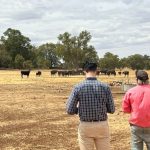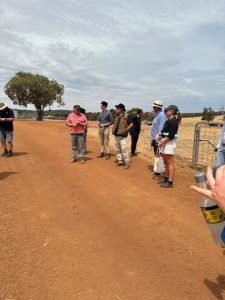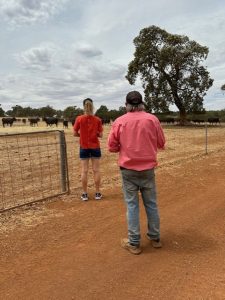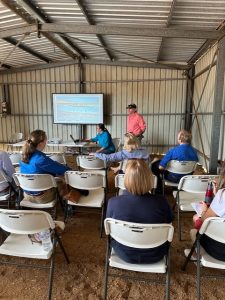News
https://www.abc.net.au/news/2024-08-26/pardoo-feedlot-global-marbled-wagyu-beef-supply/104270756
Beef market analyst Matt Dalgleish said Pardoo Wagyu stook alongside the likes of Gina Rinehart and Andrew Forrest in its confidence in the long-term demand for marbled meat.
“As a response to the cyclone, we constructed temporary cattle feed yards to facilitate to ensure the weaners on-site could continue to be fed with a high level of animal welfare standards during this transitional phase,” he said.
The company’s ambition is to build a backgrounding facility that will eventually hold more than 14,000 young Wagyu cattle weighing 350 kilograms each.

A Pilbara cattle station will build a 10,000-head backgrounding facility in a move it expects to bolster the region’s status as a global premium boxed Wagyu beef supplier.
Pardoo Station on Friday gained approval from the Shire of East Pilbara to build its feedlot on the station 150 kilometres east of Port Hedland.Pardoo plans to build the 28-hectare facility in two stages and, once complete, will be capable of handling 14,705 350-kilogram-class weaners.
http://A Pilbara cattle station will build a 10,000-head feedlot in a move it expects to bolster the region’s status as a global premium boxed Wagyu beef supplier.
https://www.businessnews.com.au/article/Pardoo-to-build-cattle-feedlot

Stellar attendance at the Evoke Ag side event at Pardoo Wagyu’s Shogo Takeda Genetics Centre on 19 February 2024. An audience consisting of producers, researchers, industry specialists, State and federal government, agronomists had the opportunity to preview Pardoo Wagyu’s breeding facility just north of Perth.
Presentations were delivered covering the Pardoo Wagyu growth over nine years of operation and the importance of meticulous attention to genetics to qualify for a true genetics to plate experience.
Chef Jed Gerrard conjured up some mouth watering MS8 Pardoo Wagyu which was enjoyed by all.
Supported by the Department of Primary Industries and Regional Development.









It is with deep sadness that we have heard the news of the passing of Mr Shogo Takeda, a long standing Wagyu guru and friend of Pardoo. Pardoo Wagyu grieves with his family and friends of the Wagyu industry on the passing of such an icon.
“We have been fortunate to have received Mr Takeda at Pardoo in the Pilbara on many occasions and I have travelled annually to his hometown in Shiraoi Hokkaido, Japan as recently as last month. He has supported our Pardoo vision from day one and generously imparted his breeding knowledge, experience and foundation genetics to us and his legacy will stay on through our growing Wagyu herd, an extension of his vision.”
Mr Takeda dedicated much of his life to enabling the development of the global Wagyu industry outside of Japan. The Australian Wagyu industry has paid particular attention and dedication to Mr Takeda and his advice on breeding. There is no doubt that a large part of the success and scale of our industry today is a result of Mr Takeda’s efforts.
Mr Takeda is a pioneer of Wagyu in Japan, just as he is for the rest of the world. He is credited with being the first person to introduce Wagyu cattle into the island of Hokkaido in 1954. His Takeda Farm has been breeding Japanese Black cattle since then and still does today, with Mr Takeda considered a Master Breeder.
Believing the world would benefit from Wagyu genetics, he made the decision to export 35 females and 5 males to the USA in 1995. Many of those females were in calf. A second shipment of 45 females and 6 males occurred in 1996. Mr Takeda said:
“A long time ago, Japan imported Jersey Cattle from Australia. Thanks to this, the Japanese people can now enjoy drinking tasty milk and eating tasty yoghurt. After I exported my Wagyu cattle to the US in the early 1990’s hoping that people in the world would enjoy eating Wagyu beef, the first people who purchased my genetics were Australians.”
Mr Takeda is highly regarded around the world for his mastery of breeding highly productive cattle that achieved the best levels of carcass performance, but also had milking ability and maternal performance. During the formative years of the Australian Wagyu industry, Mr Takeda worked hand in hand with many Australian and International breeders to help them understand Wagyu genetics and his rotational breeding program.
The enormity of the legacy left behind by Mr Takeda cannot be denied. In dreaming to provide the World the opportunity to experience Wagyu, he has played a pivotal role in establishing a global luxury protein market for Wagyu beef that is underpinned by the Australian industry expansion of his genetics.
In recognition of the enormous impact that Shogo Takeda has had on the Australian Wagyu Industry, Mr Takeda was awarded as the AWA’s first Hall of Fame inductee in 2015. Mr Takeda said: “Australia has been the centre of Wagyu Production in the world outside of Japan. I deeply appreciate the Australian Wagyu breeders for their contribution to spread Wagyu genetics to the rest of the world. The members of the Australian Wagyu Association have spread Wagyu worldwide which helped my dream come true”.
With our gratitude and appreciation Takedasan we will continue to make you proud.
Bruce Cheung and all at Pardoo Wagyu
22 March 2023

Pardoo Wagyu Worth Sharing https://www.dropbox.com/s/8lp2m02pe2ocmby/Pardoo%20Wagyu%20worth%20sharing.mp4?dl=0

The Ngarla people are frequent visitors to Pardoo where they have strong heritage links from the time of their fathers and grandfathers. Here we see Mikail walking along Pardoo Creek representing the younger generation.

Joe Ross, Bunuba Director speaks to Country Hour about the relationship between Pardoo Beef and Bunuba Dawangarri Aboriginal Corporation.
https://www.abc.net.au/radio/programs/wa-country-hour/wa-country-hour/13306734

A major wagyu cattle operation in the Pilbara is a step closer to creating a $3 billion premium beef industry in WA’s north after it secured access to highly sought after pastoral land in the Kimberley.
Pardoo Beef Corporation — owned by Singaporean businessman Bruce Cheung — has negotiated a 20-year sublease over a portion of the Yarranggi pastoral lease (formerly known as Leopold Downs) with the Bunuba Dawangarri Aboriginal Corporation.
